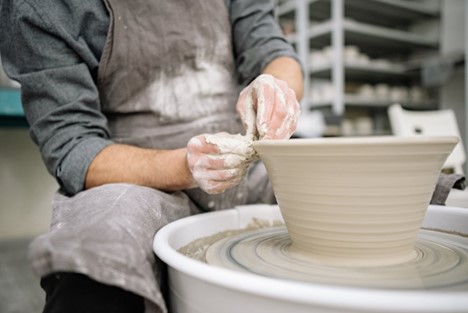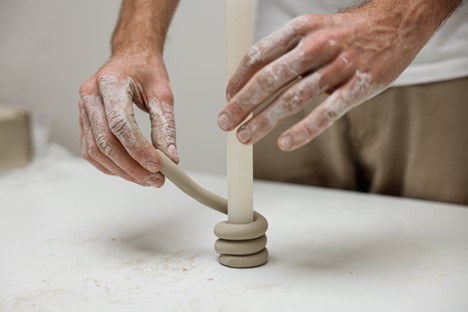Coil pottery, pinch pot, wheel throwing, carving, and slab building techniques all provide unique possibilities for artistic expression in pottery. While coil pottery and pinch pot techniques emphasize hand-building, wheel throwing depends on a spinning wheel’s precision. Carving adds fine details, while slab building allows for more flexible forms. Understanding the qualities of each technique will enable artists to select the best approach for their creative vision.
Coil Pottery Vs. Other Pottery Techniques
There are several types of pottery techniques, coil potter being one of the popular ones. Other prominent pottery techniques are pinch pot, wheel throwing, carving, and slab building. Here, we have studied the characters and uses of each technique compared to coil pottery so artists can explore their creativity.
1. Coil Pottery Vs. Pinch Pot Technique
Coil pottery and pinch pot technique are two basic yet different pottery techniques. They are similar in that they are both hand-building techniques and differ in the approach to shaping the clay. When artists use the pinch pot technique, they start the process with a ball of clay. They then gradually pinch and mold the ball of clay into the desired shape using their fingers and thumb. The method is as simple as the name suggests.
Artists prefer the pinch pot technique over other techniques because it allows intimate contact with the clay. This method helps the artists create a satisfactory, organic, and expressive shape. One way to recognize a design made using a pinch pot is its irregular contours and tactile appeal. The pinch pot technique makes small bowls, cups, and decorative pieces.
On the other hand, artists create long, snake-like coils of clay and stack them layer by layer to build the walls of the vessel in coil pottery. Artists prefer this technique over the others because it gives more control over the form and structure of the pottery. It means that artists control the thickness and stability of their building vessels.
Overall, the pinch pot technique allows artists to improvise their work spontaneously. Meanwhile, coil pottery is better for artists who prefer meticulous planning and precision.
2. Coil Pottery Vs. Wheel Throwing Technique

Wheel throwing is the pottery technique we usually see in the movies and ads. It’s also a highly popular technique among potters all around the world. The method involves shaping clay on a spinning wheel to create perfectly symmetrical forms like bowls, cups, and vases. Coil pottery, if you remember, is a hand-building approach, while wheel throwing uses a wheel to shape the form. Although artists use their hands and tools to manipulate the clay, they do so while it spins on the wheel.
While wheel throwing is the widely loved technique to create symmetrical and well-balanced vessels, coil pottery wins hearts worldwide for its inherent texture and character. Both methods, however, invite the artists to pour their heart and imagination into the clay.
If you have already mastered the coil pottery technique, why not explore the wheel-throwing technique? All you need is your reliable clay and a pottery wheel. NATIONAL GEOGRAPHIC Pottery Wheel Kit is a brilliant choice in this regard. The wheel has variable speeds you can experiment on as you slowly master another pottery technique.
3. Coil Pottery Vs. Carving Technique
The carving technique is usually used to decorate and embellish pottery surfaces to create a design on them. Artists create intricate patterns, textures, and designs to bring the form to life. Coil pottery focuses on creating the form of a vessel using coils of clay, while carving allows the artist to work on the surface of the pottery to create visual depth. There are several ways to do so. The most famous carving designs are incising, sgraffito, and relief carving. These carving designs transform an ordinary clay vessel into extraordinary works of art.
The two techniques are not mutually exclusive. They complement each other. As an artist, you can use carving techniques in your coil pottery pieces to make your work even more outstanding. The techniques can be used in the same form to add layers of meaning and storytelling.
4. Coil Pottery Vs. Slab Building Pottery
Slab building is a hand-building technique, just like coil pottery. However, this technique requires artists to roll out flat sheets of clay and assemble them into three-dimensional forms. The main difference between the two techniques lies in the shape of the clay used to create the form. As we know, coil pottery uses rolls of snake-like soils to build the structure’s wall from the bottom. The slab-building technique uses flat sections of clay. It allows the artist to play with more versatility in shape and structure. They usually create angular, geometric forms utilizing this technique. Several artists also use this approach to create organic-looking flowing shapes.
Coil pottery is all about the rhythmic repetition of coils to create the form. Slab building, on the other hand, is about experimenting with texture, surface design, and architectural elements. The two techniques are loved by artists worldwide, allowing them to experiment and explore their creative boundaries.
Which Pottery Technique is the Right Approach?
All the techniques mentioned above are the right approach to pottery. However, the choice of pottery technique depends on various factors, including the artist’s vision and technical skills. Each of the methods comes with its challenges and advantages. It should inspire artists to go beyond their comfort zone and experiment with other techniques.
There are, however, certain forms that are perfectly made using specific a pottery technique. For example, function vessels like bowls, cups, and plates are perfected using the precision and consistency wheel throwing offers. Similarly, small and decorative pieces for people who like handmade aesthetics can be done brilliantly using the pinch pot technique. Conversely, the coil pottery technique can help artists create larger vessels and sculptural forms.
Conclusion
Coil pottery is just one of the techniques artists use for clay pottery. Pinch pot, wheel throwing, carving, and slab building are other popular pottery techniques. While they all suit different purposes and artistic visions, each provides endless creative opportunities to the artists.







